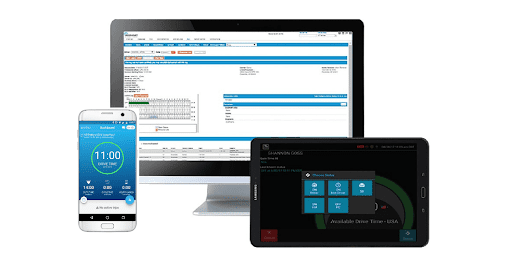Are you familiar with ELD apps? Are you curious about their benefits and drawbacks for truck drivers and fleet managers?
With few exceptions, electronic logging devices (ELDs) have become mandatory in the trucking industry. ELDs simplify hours of service (HOS) tracking and compliance, and are more time-efficient than maintaining paper logs.
In this article, we take a closer look at driver log software, how it works, and its advantages and disadvantages. Then we answer some of the most frequently asked questions on the topic of ELD applications.
How does an ELD app work?
ELD trucker apps are software applications that run on mobile devices, such as smartphones or tablets. They’re designed to electronically record a commercial driver’s hours of service in compliance with Federal Motor Carrier Safety Administration (FMCSA) regulations.
Here’s a general idea of how an electronic driver logs app works:
-
A truckers’ logbook app is installed on a smartphone or tablet that’s connected to the vehicle’s electronic control module (ECM).
-
The best electronic logbooks collect data from the ECM, including, for instance the vehicle’s speed, engine hours and miles driven.
-
The logbook app for truck drivers uses the data to create electronic logbooks that record the driver’s hours of service (HOS) and duty status.
-
Some electronic log software apps also send alerts as drivers get close to reaching their HOS limits.
-
Data collected by the electronic driver’s logbook app can be transmitted to fleet management personnel for compliance monitoring and reporting.
Overall, a driver’s log book app simplifies the process of recording and reporting HOS information for commercial vehicle drivers. At the same time, it benefits drivers and fleet managers by providing real-time data that helps improve safety and efficiency.
Fines and penalties for non-compliance with the ELD mandate can be stiff. For instance, fees for record of duty status (RODS) violations cost more than $8,000, on average. In fact, the top settlement for falsifying records exceeded $135,000.
For more information about the implications of non-compliance, read What happens if you unplug your ELD?
Advantages of using an ELD app
ELD trucking apps are often used by owner-operators and small fleet owners who want an affordable and easy-to-use ELD solution. The best trucker apps simplify the lives of those using them.
Electronic logging device apps provide:
-
Automated records of driving times, rest periods and breaks to ensure accurate HOS tracking
-
Time savings compared to manual record keeping
-
Real-time access to data that helps fleet managers and owner-operators make better-informed decisions
-
Enhanced road safety by preventing driver fatigue-related accidents
-
Reduced expenses associated with truck logbook non-compliance, such as higher insurance premiums and fines
Read more about how technologies like driver apps are improving the driver experience.
Disadvantages of using an ELD app
Although electronic logs have many advantages, there are also some disadvantages, including:
-
Equipment and installation costs, which increase if you’re looking for more advanced, optional features
-
Potential incompatibility or configuration issues leading to inaccurate data collection that may result in fines or other penalties
-
A learning curve as drivers are trained to use the driver log app
What makes an ELD app different?
An electronic logbook app is different from other fleet management and tracking applications because it’s specifically designed to comply with FMCSA regulations.
These regulations mandate strict guidelines for recording driving hours, breaks and other related data.
As a result, a trucker logbook app must accurately record and transmit this data to ensure compliance with these rules. Additionally, truck log book apps typically offer features such as real-time tracking, route optimization, and vehicle maintenance tracking to further assist commercial drivers and fleets.
What are the ELD exemptions?
While most commercial motor vehicle drivers are required to comply with ELD regulations, exemptions do apply in certain situations.
Here are some examples of ELD mandate exemptions:
-
Drivers who use paper records of duty status (RODS) for eight days or fewer during any 30-day period
-
Drivers who don’t operate beyond a 150-air-mile radius of their normal work location
-
Drivers of vehicles that were manufactured before the model year 2000
-
Drivers who conduct drive-away-tow-away operations, where the vehicle being driven is the commodity being delivered
-
Drivers who operate as part of a drive-away operation that involves the delivery of a motor home or a recreational vehicle trailer (RVT) to a dealership or a customer.
You should know that even drivers who are exempt from the ELD mandate must comply with HOS regulations. Instead of having to use an ELD, they’re required to keep accurate paper records of their driving hours.
ELDs are important for the trucking industry
Drivers’ daily log apps are a valuable tool for improving compliance with HOS regulations. They also benefit drivers and fleet managers by boosting efficiency, reducing paperwork and administrative tasks, and enhancing road safety.
With so many electronic logbook apps available, truckers should carefully evaluate their options based on individual needs, preferences and budgets. To identify some of the top ELD providers for your business, read our guide to buying the best ELD.
However, it is important to note that the best ELD devices alone can’t replace driver skill, experience and professionalism. Truckers play a critical role in maintaining the integrity of the industry and ensuring the timely delivery of goods across the country.
FAQ
With few exceptions, you’re legally required to use an electronic logbook device (ELD) to record your hours of service. Truck log software helps to prevent fatigue and ensure compliance with the Federal Motor Carrier Safety Administration (FMCSA) regulations. The best ELD for trucks will also help with tracking loads and improving communications with dispatchers or fleet managers.
Typically, a driving log book app should transmit data at least hourly while driving, and whenever a duty status changes. This could range anywhere from a few kilobytes to several megabytes. However, to get a more accurate estimate, it’s best to refer to the ELD manufacturer’s data usage specifications.
Older trucks are exempt from the ELD requirement because they don’t have the equipment or technology needed to support it. This is based on the assumption that older trucks don’t travel as far, as often or as long as newer vehicles. They’re therefore less likely to pose a risk to the public.


